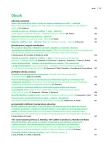Management of patients with dyspepsia
Authors:
Eduard Veseliny; Mária Zakuciová; Martin Janíčko; Peter Jarčuška
Authors‘ workplace:
I. interná klinika LF UPJŠ a UN L. Pasteura Košice, Slovenská republika, prednosta prof. MUDr. Daniel Pella, PhD.
Published in:
Vnitř Lék 2014; 60(7-8): 657-663
Category:
100th Birthday - prof. Z. Mařatka
Overview
Dyspepsia is a common clinical problem with an extensive differential diagnosis and a heterogeneous pathophysiology. Dyspepsia affects up to 40 % of the general population and significantly reduces quality of life. According to the Rome III criteria, dyspepsia is defined as one or more of the following symptoms: epigastric pain and/or burning (classified as epigastric pain syndrome), postprandial fullness and/or early satiation (classified as postprandial distress syndrome). Initial evaluation should focus on the identification and treatment of potential causes of symptoms such as gastroesophageal reflux disease, peptic ulcer disease, and medication side effects but also on recognizing those at risk for more serious conditions such as gastric cancer. An empiric PPI trial or “test and treat” strategy for Helicobacter pylori are the initial approaches to a patient with dyspepsia, followed by endoscopy if initial management fails. Once an organic cause for symptoms is excluded, a diagnosis of functional dyspepsia is made. This article will review the definition, etiology, and general approach to the evaluation and management of the patient with dyspepsia including the role of proton-pump inhibitors, treatment of Helicobacter pylori, and endoscopy.
Key words:
dyspepsia – functional dyspepsia – Helicobacter pylori – proton-pump inhibitors
Sources
1. Mařatka Z. Funkční trávicí poruchy. In: Mařatka Z (ed). Gastroenterologie. Karolinum: Praha 1999: 407–434. ISBN 9788071845614.
2. Tack J, Talley NJ, Camilleri M et al. Functional gastroduodenal disorders. Gastroenterology 2006; 130(5): 1466–1479.
3. Ford AC, Forman D, Bailey AG et al. Effect of dyspepsia on survival: a longitudinal 10-year follow-up study. Am J Gastroenterol 2012; 107(6): 912–921.
4. Veseliny E, Zakuciová M, Jarčuška P. Manažment a racionálna farmakoterapia dyspepsie. Metodický list racionálnej farmakoterapie 2007; 11(7): 1–4.
5. Moayyedi P, Forman D, Braunholtz D et al (Leeds HELP Study Group). The proportion of upper gastrointestinal symptoms in the community associated with Helicobacter pylori, lifestyle factors, and nonsteroidal anti-inflammatory drugs. Am J Gastroenterol 2000; 95(6): 1448–1455.
6. El-Serag HB, Talley NJ. Systematic review: the prevalence and clinical course of functional dyspepsia. Aliment Pharmacol Ther 2004; 19(6): 643–654.
7. Talley NJ, Vakil NB, Moayyedi P. American gastroenterological association technical review on the evaluation of dyspepsia. Gastroenterology 2005; 129(5): 1756–1780.
8. Shaib Y, El-Serag HB The prevalence and risk factors of functional dyspepsia in a multiethnic population in the United States. Am J Gastroenterol 2004; 99(11): 2210–2216.
9. Ramsoekh D, van Leerdam ME, Rauws EA et al. Outcome of peptic ulcer bleeding, nonsteroidal anti-inflammatory drug use, and Helicobacter pylori infection. Clin Gastroenterol Hepatol 2005; 3(9): 859–864.
10. Papatheodoridis GV, Sougioultzis S, Archimandritis AJ Effects of Helicobacter pylori and nonsteroidal anti-inflammatory drugs on peptic ulcer disease: a systematic review. Clin Gastroenterol Hepatol 2006; 4(2): 130–142.
11. Harmon RC, Peura DA. Evaluation and management of dyspepsia. Therap Adv Gastroenterol 2010; 3(2): 87–98.
12. Behar J, Corazziari E, Guelrud M et al. Functional gallbladder and sphincter of oddi disorders. Gastroenterology 2006; 130(5): 1498–1509.
13. Malfertheiner P, Megraud F, O’Morain C et al. Current concepts in the management of Helicobacter pylori infection: the Maastricht III Consensus Report. Gut 2007; 56(6): 772–781.
14. Gatta L, Vakil N, Ricci C et al. Effect of proton pump inhibitors and antacid therapy on 13C urea breath tests and stool test for Helicobacter pylori infection. Am J Gastroenterol 2004; 99(5): 823–829.
15. Hunt RH, Xiao SD, Megraud F et al. Helicobacter pylori in developing countries. World Gastroenterology Organisation Global Guideline. J Gastrointestin Liver Dis 2011; 20(3): 299–304.
16. Ford AC, Marwaha A, Lim A et al. What is the prevalence of clinically significant endoscopic findings in subjects with dyspepsia? Systematic review and meta-analysis. Clin Gastroenterol Hepatol 2010; 8(10): 830–837.
17. Delaney BC, Innes MA, Deeks J et al. Initial management strategies for dyspepsia. Cochrane Database Syst Rev 2001; (3):CD001961. (Update)
18. Mason I, Millar LJ, Sheikh RR et al (Compete Research Group). The management of acid-related dyspepsia in general practice: a comparison of an omeprazole versus an antacid-alginate/ranitidine management strategy. Aliment Pharmacol Ther 1998; 12(3): 263–271.
19. Moayyedi P, Soo S, Deeks J et al. Eradication of Helicobacter pylori for non-ulcer dyspepsia. Cochrane Database Syst Rev 2005; (1): CD002096.
20. Soo S, Forman D, Delaney BC et al. A systematic review of psychological therapies for nonulcer dyspepsia. Am J Gastroenterol 2004; 99(9): 1817–1822.
Labels
Diabetology Endocrinology Internal medicineArticle was published in
Internal Medicine

2014 Issue 7-8
Most read in this issue
- Endoscopic classification of colon and rectal neoplasias
- Acute pancreatitis – Validation of Revised Atlanta Classification on 159 patients and prognostic factors
- Crohn's Disease Surgery
- Management of patients with dyspepsia
